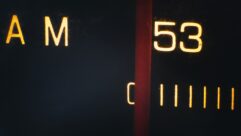Stu Engelke is CE of New York City’s WNYM, “AM 970 The Apple.” The station has a Carl T. Jones phasor, controlled by a Kintronic phasor controller and indicator panel. Stu experienced an intermittent malfunction recently while the phasor was switching from Night to Day pattern. Stu used a USB webcam to troubleshoot the failure. Here’s how it played out.
Every few days, the change from Night to Day pattern was not completing. Things would not switch properly. With all the contactors and relays, the problem could be anywhere. To make matter worse, each time Stu tried switching the system while he was at the site, everything worked perfectly.
Back at his office, Stu noticed a webcam that was not in use, sitting on a shelf. The idea hit him to record the status indicators of the Burk remote control and Kintronic phasor controller and indicator panel during the pattern change.
He set up the Web camera at the transmitter site. Mounting was simple; it just sat on the floor, aimed up at the rack so it could see the controller, the status panel and the Burk remote control.
A few days later, when the failure occurred, the results were not what Stu expected. He had set the PC to record from 2 minutes before the change to 10 minutes after. Here is what the camera recorded.

Fig. 1: A webcam is used to diagnose phasor switching. This image shows normal status before the switch to Day mode.

Fig. 2: Status indications during the switch to Day pattern. Fig. 1 shows the normal Night mode indicators, before the switch. Fig. 2 shows the status during the pattern change. In Fig. 3 we see what a successful switch to Day pattern looks like. But looking at Fig. 4, we see the contactor status indicators are all lit properly, but the status light to the remote control is not lit.
As it turns out, Stu thought he was going to see a contactor not switching. But this did not occur, as all the contactor indicators were green (seen on the bottom of the controller indicator panel). It turned out that a slave relay that Stu had installed to get the Day status to the Burk remote control was not activating. That relay has been replaced, and there have been no further problems.

Fig. 3: Indicators show a successful switch to Day pattern.

Fig. 4: The failed mode. Note there is no status indicator on the remote control. The pattern had been switched properly, but the remote control did not know it, since the slave relay was not pulling in. Stu has the system programmed to switch back to Night, if there is an error, and that is exactly what the system did.
Stu writes that his next use for the camera is to find out who’s taking his food out of the station refrigerator.
* * *
We’ve had a lot to say about substituting LEDs for incandescent bulbs in the last few columns.
Paul Sagi, a broadcast engineer from Kuala Lumpur, Malaysia, offers a reminder. When the bulb being replaced is powered by AC, Paul has used a capacitor to limit the LED current. This application works well in higher-voltage situations.
Paul also uses a bi-polar red/green LED. When fed with AC, it glows yellow. In order to save space, Paul uses a tantalum capacitor. To make it bipolar, he connects two tantalum capacitors in series, negative to negative. The capacitors are about two times the value he wants. This is because they are in series. If a uni-polar LED is used, a diode must be placed in inverse parallel with the led so the capacitor has AC through it.
As mentioned, this works well when the AC voltage is high enough that a series resistor would dissipate too much power. Paul cautions to be sure the capacitor voltage rating is high enough, usually a minimum of twice the supply voltage.
Also remember that placing two capacitors in series gives the advantage of double the voltage rating.
One nice thing about LEDs is the many colors available. You can light your rack up like a Christmas tree. The colored meter faces are impressive to visitors to the station. Be sure to dim the lights!
John Bisset has worked as a chief engineer and contract engineer for 39 years. He is international sales manager for Europe and Southern Africa for Nautel and a past recipient of the SBE’s Educator of the Year Award. Reach him at[email protected]. Faxed submissions can be sent to (603) 472-4944.
Submissions for this column are encouraged and qualify for SBE recertification credit.












